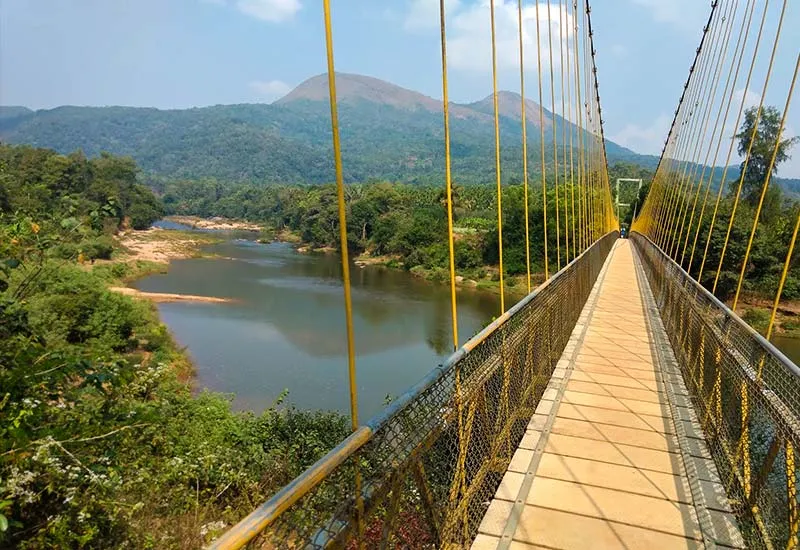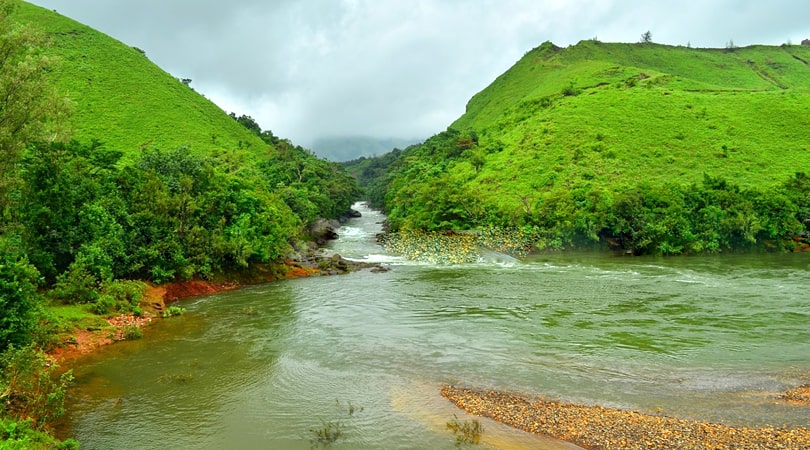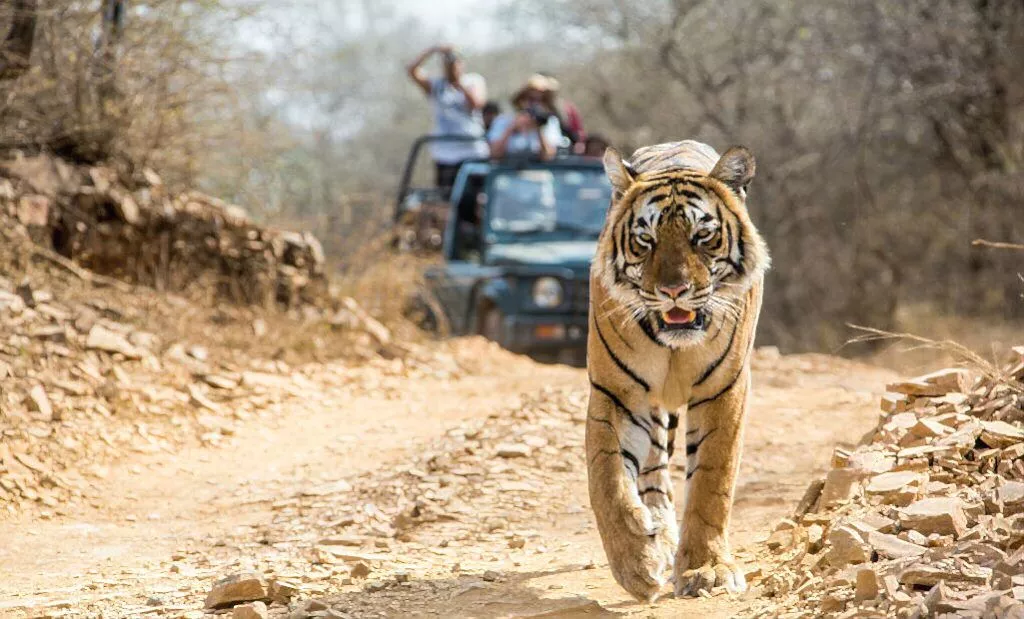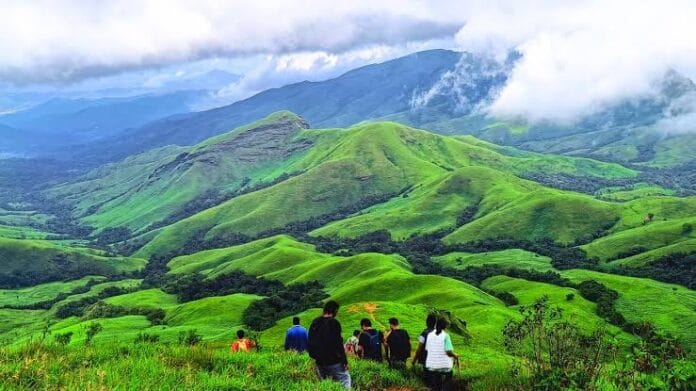Table of Contents
Introduction
Imagine walking through a dreamy green paradise where rolling hills stretch endlessly, mist gently hugs the mountain tops, and the only sound you hear is the rustling of leaves and birdsong. That’s Kudremukh trekking for you — one of Karnataka’s most breathtaking adventures and a haven for nature lovers, trekkers, and wildlife enthusiasts alike.
Whether you’re an avid trekker looking for your next challenge or someone who just wants to soak in some lush, untouched beauty, Kudremukh offers the perfect escape from the noise of city life. Let’s dive into everything you need to know about planning your Kudremukh trekking experience!
Where is Kudremukh?
Kudremukh, which literally means “Horse Face” in Kannada, is a mountain range located in the Chikkamagaluru district of Karnataka. It’s part of the Western Ghats, a UNESCO World Heritage Site known for its rich biodiversity and stunning landscapes.
The peak gets its name because, from certain angles, the mountain resembles the face of a horse. At an elevation of 1,894 meters (6,214 ft), Kudremukh is the third highest peak in Karnataka and is nestled within the Kudremukh National Park, a protected area home to many endangered species and thick shola forests.

Why Kudremukh is a Top Trekking Destination in Karnataka
There are treks, and then there’s Kudremukh trekking — a soul-stirring journey that takes you through dense forests, rolling grasslands, serene streams, and panoramic mountain views.
Here’s why Kudremukh stands out:
- Unspoiled Natural Beauty: Unlike commercialized trekking spots, Kudremukh trekking feels like a hidden gem. The scenery changes dramatically as you ascend — from dark woods to open meadows and cloud-kissed summits.
- Rich Biodiversity: As part of a protected national park, the area is teeming with wildlife. You might spot deer, Malabar giant squirrels, and even traces of wild elephants.
- A Perfect Challenge: The trail isn’t too easy, nor is it extreme. It strikes the right balance, making it accessible for moderately fit beginners and rewarding for seasoned trekkers.
Best Time to Visit Kudremukh for Trekking
Timing is everything when it comes to trekking, and Kudremukh is best experienced between October and February.
- October to February ( Post-monsoon/Winter): This is the ideal time. The hills are lush green, the weather is pleasant, and visibility is great for panoramic views.
- June to September (Monsoon): Kudremukh receives heavy rainfall, which makes the trail slippery and risky, though incredibly green and photogenic.
- March to May ( Summer): It gets warmer, and the greenery fades. Not the best time if you’re looking for that fresh post-monsoon look.

How to Reach Kudremukh from Major Cities
By Road:
- From Bangalore: 330 km – around 7 to 8 hours drive
- From Mangalore: 100 km – about 3 hours
- From Chikkamagaluru: 95 km – roughly 2.5 hours
The nearest village to the trek base is Mullodi, which is accessible via Kalasa. From Kalasa, you’ll need to hire a jeep to reach Mullodi, as the road gets rough and narrow.
By Bus:
- You can take KSRTC or private buses to Kalasa or Kudremukh town from Bangalore or Mangalore.
- From Kalasa, take a jeep to Mullodi (base camp).
By Train:
- The nearest railway station is Mangalore, well-connected to major cities.
- From Mangalore, take a taxi or bus to Kalasa.
By Air:
- Nearest airport is Mangalore International Airport (IXE), about 100 km away.
Kudremukh Trekking Trail Details & What to Expect
Let’s talk trail! The Kudremukh trek is around 20-22 km (round trip) and typically takes 6–8 hours to complete, depending on your pace.
Trek Details:
- Starting Point: Mullodi village (after checking in at the forest office)
- Peak Altitude: 1,894 meters
- Trek Type: Forest and grassland trail, moderate difficulty
- Time Taken: 4–5 hours uphill, 2–3 hours downhill
- Trail Highlights:
- Crossing multiple small streams
- Walking under thick canopy
- Endless rolling meadows with dramatic views
- Reaching the horse-face viewpoint — totally Instagram-worthy!
Difficulty Level:
- Moderate: You’ll need decent stamina and good shoes.
- Not recommended for people with mobility issues.
- Beginners can manage it with basic fitness and determination.

Permits and Entry Fee Details
Since the trek is inside Kudremukh National Park, a permit is mandatory.
Entry Detail
- Permit Fee: ₹600 per person (as of 2025)
- Guides: Mandatory (usually arranged by homestays or at the forest office)
- Where to Get It: Forest office at Mullodi or through your homestay
- Trek Limit: Only 50 trekkers allowed per day, so book early!
Tip: Carry a valid ID card, and avoid plastic – the forest department is strict about keeping the place clean.
Essential Tips & Packing List for Kudremukh Trekking
Be prepared, and your Kudremukh adventure will be smooth and memorable!
Packing Checklist:
- Comfortable trekking shoes with good grip
- Light backpack (20-30L)
- Reusable water bottle (at least 2L)
- Energy bars/snacks
- Rain jacket or poncho (especially post-monsoon)
- Cap, sunglasses, and sunscreen
- Small towel and personal toiletries
- First-aid kit with basic meds
- Torchlight/headlamp
- Power bank for phones/cameras
Tips:
- Start early (by 6:30–7:00 AM) to beat the sun and finish before dark
- Avoid wearing shorts — there are leeches during the wet season
- Carry cash — there are no ATMs near Mullodi
- Book your homestay and permit at least a week in advance, especially on weekends.

Local Experiences & Nearby Attractions
- Kudremukh National Park
Rich in biodiversity with lush forests, rivers, and trekking trails. Home to endangered species like the lion-tailed macaque and Malabar civet. Ideal for nature lovers, bird watchers, and wildlife photographers. - Hanuman Gundi Falls
Located around 20 km from Kudremukh, this beautiful waterfall cascades from 22 meters, surrounded by rocks and greenery. A great spot for a short hike and picnic. - Lakya Dam
A check dam built across the Lakya River offering peaceful views, surrounded by hills and forests. Access may be restricted at times. - Kalasa
A small temple town about 20 km away, famous for the Kalaseshwara Temple dedicated to Lord Shiva. Set along the banks of the Bhadra River. - Horanadu (Sri Annapoorneshwari Temple)
Located around 35 km from Kudremukh, this revered temple is dedicated to Goddess Annapoorneshwari and is known for offering free meals to all visitors. - Gangamoola (Varaha Parvatha)
The origin point of three rivers: Tunga, Bhadra, and Nethravathi. Ideal for trekking and cave exploration, and part of Kudremukh National Park. - Bhagavathi Nature Camp
An eco-tourism camp inside Kudremukh National Park that offers basic stays and guided treks. Great for wildlife spotting and peaceful forest experiences.

Conclusion: Ready for the Kudremukh Adventure?
Whether it’s the thrill of reaching the summit, the joy of walking through lush green meadows, or the serenity of the untouched Western Ghats — Kudremukh trekking offers an experience that stays with you long after the boots come off.
So, pack your bags, round up your trek gang, and get ready to explore one of Karnataka’s most spectacular natural wonders. Kudremukh isn’t just a trek — it’s a story you’ll want to tell again and again.
Let the hills call you — because Kudremukh is waiting!
❓ Frequently Asked Questions about Kudremukh Trekking
1. Is Kudremukh trek open all year round?
No, the Kudremukh trek is generally open from October to May. It’s closed during peak monsoon season (usually June to September) due to heavy rains and safety concerns.
2. Is prior booking required for the Kudremukh trek?
Yes, prior booking is highly recommended, especially on weekends. The forest department only allows 50 trekkers per day, so book early to avoid missing out.
3. Do I need a guide for the Kudremukh trek?
Yes, having a registered local guide is mandatory as per the forest department rules. Most homestays arrange this for you as part of the trekking package.
4. Is Kudremukh trekking suitable for beginners?
Yes! The trek is moderately difficult and can be done by beginners with reasonable fitness. It’s around 20 km (round trip) but not too steep or technical.
5. Are there any accommodation options near Kudremukh?
Yes, there are several homestays in Mullodi and Kalasa that offer basic but comfortable accommodation, local food, and guide services.
6. Can we camp at Kudremukh peak?
No, camping is not allowed inside the Kudremukh National Park due to wildlife protection regulations. Trekkers must return to base before sunset.
7. Are food and water available during the trek?
There are no food stalls or shops on the trail. You must carry your own water (minimum 2L) and snacks. Homestays provide packed lunch or breakfast before the trek.
8. Are leeches a problem in Kudremukh?
Yes, especially during and after the monsoon season (June to October), leeches are common on the trail. Wear full-length pants and carry salt or Dettol spray as a precaution.

